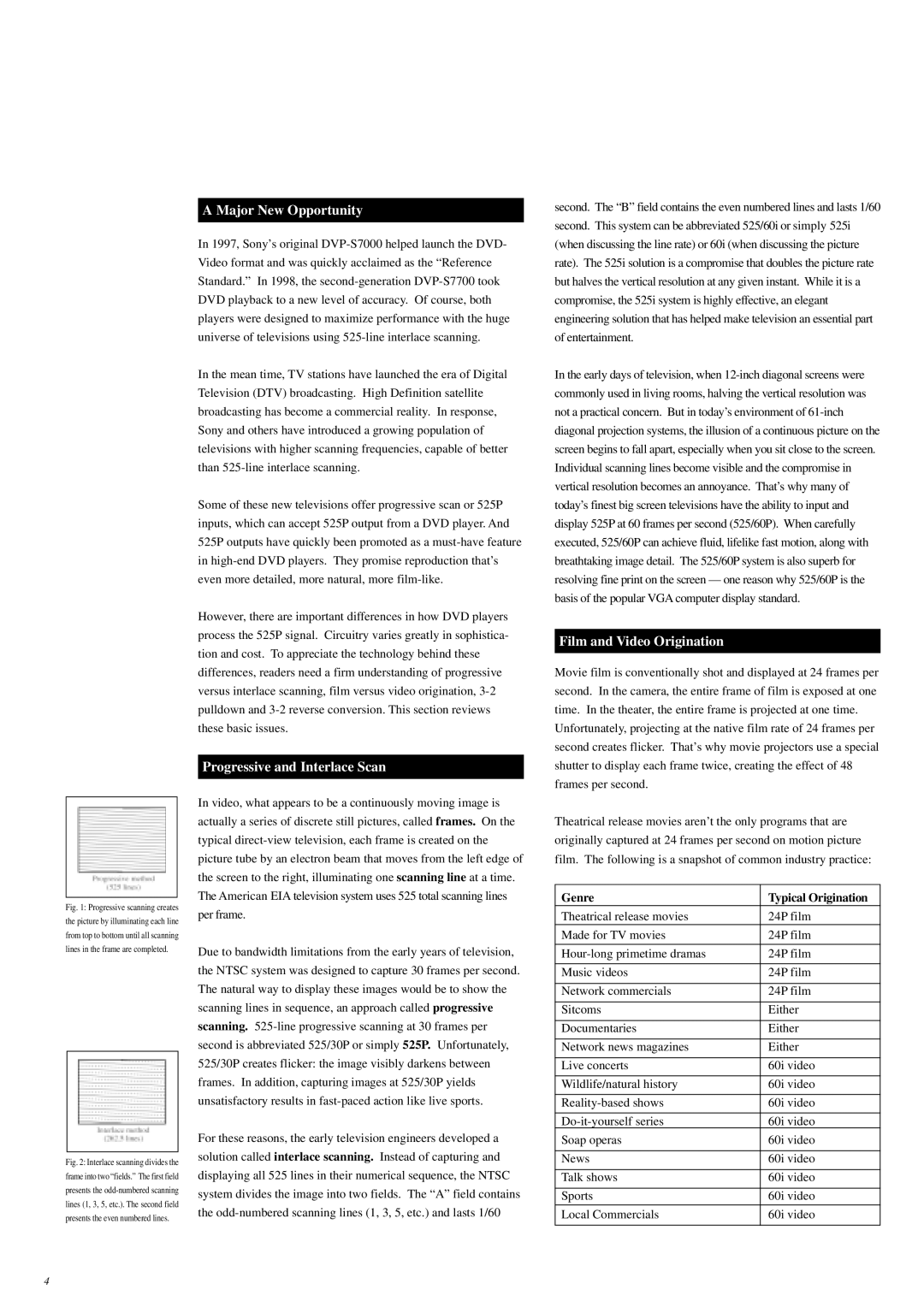A Major New Opportunity
In 1997, Sony’s original DVP-S7000 helped launch the DVD- Video format and was quickly acclaimed as the “Reference Standard.” In 1998, the second-generation DVP-S7700 took DVD playback to a new level of accuracy. Of course, both players were designed to maximize performance with the huge universe of televisions using 525-line interlace scanning.
In the mean time, TV stations have launched the era of Digital Television (DTV) broadcasting. High Definition satellite broadcasting has become a commercial reality. In response, Sony and others have introduced a growing population of televisions with higher scanning frequencies, capable of better than 525-line interlace scanning.
Some of these new televisions offer progressive scan or 525P inputs, which can accept 525P output from a DVD player. And 525P outputs have quickly been promoted as a must-have feature in high-end DVD players. They promise reproduction that’s even more detailed, more natural, more film-like.
However, there are important differences in how DVD players process the 525P signal. Circuitry varies greatly in sophistica- tion and cost. To appreciate the technology behind these differences, readers need a firm understanding of progressive versus interlace scanning, film versus video origination, 3-2 pulldown and 3-2 reverse conversion. This section reviews these basic issues.
Progressive and Interlace Scan
In video, what appears to be a continuously moving image is actually a series of discrete still pictures, called frames. On the typical direct-view television, each frame is created on the picture tube by an electron beam that moves from the left edge of the screen to the right, illuminating one scanning line at a time. The American EIA television system uses 525 total scanning lines per frame.
Due to bandwidth limitations from the early years of television, the NTSC system was designed to capture 30 frames per second. The natural way to display these images would be to show the scanning lines in sequence, an approach called progressive scanning. 525-line progressive scanning at 30 frames per second is abbreviated 525/30P or simply 525P. Unfortunately, 525/30P creates flicker: the image visibly darkens between frames. In addition, capturing images at 525/30P yields unsatisfactory results in fast-paced action like live sports.
For these reasons, the early television engineers developed a solution called interlace scanning. Instead of capturing and displaying all 525 lines in their numerical sequence, the NTSC system divides the image into two fields. The “A” field contains the odd-numbered scanning lines (1, 3, 5, etc.) and lasts 1/60
second. The “B” field contains the even numbered lines and lasts 1/60 second. This system can be abbreviated 525/60i or simply 525i (when discussing the line rate) or 60i (when discussing the picture rate). The 525i solution is a compromise that doubles the picture rate but halves the vertical resolution at any given instant. While it is a compromise, the 525i system is highly effective, an elegant engineering solution that has helped make television an essential part of entertainment.
In the early days of television, when 12-inch diagonal screens were commonly used in living rooms, halving the vertical resolution was not a practical concern. But in today’s environment of 61-inch diagonal projection systems, the illusion of a continuous picture on the screen begins to fall apart, especially when you sit close to the screen. Individual scanning lines become visible and the compromise in vertical resolution becomes an annoyance. That’s why many of today’s finest big screen televisions have the ability to input and display 525P at 60 frames per second (525/60P). When carefully executed, 525/60P can achieve fluid, lifelike fast motion, along with breathtaking image detail. The 525/60P system is also superb for resolving fine print on the screen — one reason why 525/60P is the basis of the popular VGA computer display standard.
Film and Video Origination
Movie film is conventionally shot and displayed at 24 frames per second. In the camera, the entire frame of film is exposed at one time. In the theater, the entire frame is projected at one time.
Unfortunately, projecting at the native film rate of 24 frames per second creates flicker. That’s why movie projectors use a special shutter to display each frame twice, creating the effect of 48 frames per second.
Theatrical release movies aren’t the only programs that are originally captured at 24 frames per second on motion picture film. The following is a snapshot of common industry practice:
Genre | Typical Origination |
Theatrical release movies | 24P film |
Made for TV movies | 24P film |
| |
Hour-long primetime dramas | 24P film |
| |
Music videos | 24P film |
| |
Network commercials | 24P film |
| |
Sitcoms | Either |
| |
Documentaries | Either |
| |
Network news magazines | Either |
| |
Live concerts | 60i video |
| |
Wildlife/natural history | 60i video |
| |
Reality-based shows | 60i video |
| |
Do-it-yourself series | 60i video |
Soap operas | 60i video |
| |
News | 60i video |
| |
Talk shows | 60i video |
| |
Sports | 60i video |
| |
Local Commercials | 60i video |
| |

